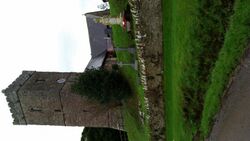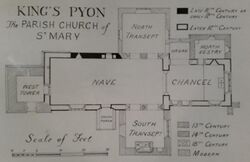Religion:King's Pyon Church
King's Pyon Church is a medieval parish church dedicated to St Mary in King's Pyon, Herefordshire. It is a Grade I listed building.[1][2]
Introduction:
The church is cruciform in plan and dates from the 12th, 13th and 14th century with additions and restoration in 1872. It is constructed from sandstone rubble with sandstone dressings and some tufa with sandstone slate and tile roofs. The earliest surviving masonry is a section of the north wall of the nave, which can be dated to the early Norman period; possibly as early as the late eleventh century.
The church sits on top of a steep slope above a giant redwood tree to the north, planted in memory of Queen Victoria's Diamond Jubilee in 1897. It is one of the Pyon Group of parishes in the rolling countryside west of Leominster. The parish also includes the small hamlet of Ledgemoor, between Kings Pyon and Weobley, which has its own stone built mission chapel, and a well used village hall. Although King's Pyon used to have its own village hall it was demolished almost 60 years ago, and thus the church itself is now the focus of community activities.
Local arable farms also produce cider apples and soft fruit crops, and breed sheep and cattle. King’s Pyon was the home of the Tomkins family who were prime movers in the development of the internationally known Hereford cattle breed, which still flourishes in the area.
The population of the parish is about 250. All newcomers to the area are made most welcome by the church and local community.
There are 28 people on the Electoral Roll, with an encouraging number of average attendance. The church has an enthusiastic and well attended choir and organist at all its weekly services, and is fortunate to have lay members of the church keen to lead services when required.
Historical Features and Development:
The church dates back before the Norman era, and is listed in the Domesday Book of 1086. The inside of the roof of the nave and south transept date from the 14th century and have a magnificent two tiered structure of black trefoiled headed wind-braces to each slope, in sharp contrast to the whitewashed ceiling.
Inside the church is an elaborately decorated tomb recess, probably 13th or 14th century, with a chest tomb beneath carrying the alabaster effigy of a man in armour at whose feet lies a stylised lion. His limbs have been amputated, probably when much of the interior decoration of the Church was destroyed by Scottish mercenary troops of the Parliamentarians during the siege of Hereford in 1645.[3] Also to be found in the South Transept are two beautiful memorial windows installed by the King family about a 100 years ago.
There is an intricately carved Victorian altar screen at the east end of the church, and another in the west end behind the elaborate Victorian font, all in memory of former family members of the congregation as well as numerous memorial plaques and windows which trace the history of the principal families and benefactors of the church over the years. A carved panelled pulpit and a readers lectern sit either side of the chancel.
The Victorian addition of the north transept has recently been refurbished to serve as a community area and incorporates a discreet kitchenette, cupboards and book shelves. The original Norman font of the church is displayed under the memorial window. This area is especially important to the community in the absence of a village hall within Kings Pyon itself, and will be put to further good use for bring and buy sales, talks, concerts, exhibitions, christenings and other gatherings.
The recent restoration project of the church was finished at the end of 2017 and also addressed the needs of the last Quinquennial Report. The project was principally funded by the Heritage Lottery Fund, and also included the repointing of the external walls of the chancel and north and south transepts of the church, the relining of the organ roof above the vestry, renewal of the guttering, and the restoration of the mullioned window in the south transept. Book sales also provide a useful form of library for parishioners.
The square tower dates from the 14th century, in which hang five bells from the early 17th century, and are rung frequently by enthusiastic campanologists. The tower incorporates a three faced clock, which chimes the hour, and was installed in 1872.
The most recent project followed two previous restoration projects, over the last 10 years or so, to restore the tower, and to "Save the Nave" and roof of the church.
Activities and Fundraising:
The PCC promotes a wide range of activities to attract community involvement and raise funds for the church. The parish is both solvent and financially independent and able to pay its Parish Share. Apart from weekly donations, other activities including the annual summer fete, baking competitions, St Nicholas Fairs, Bring and Buy sales, concerts and recitals, add to the parish fund raising efforts. In addition to book sales, the monthly parish bingo also meets a social as well as a financial benefit, and has been running for about twenty years.
Other communal activities include Churchyard maintenance, to develop a balance between a neatly kept churchyard, and the preservation of a sanctuary for wildlife, especially for bats and swifts. Ride and Stride is also an annual event of the church calendar.
The monthly Pyonear magazine effectively links the Pyon Group of parishes together, and adds a sense of cohesion and identity within the area.
For more information, see “Current Events" under the Pyon Group of Churches.
References
- ↑ "Name: CHURCH OF ST MARY List entry Number: 1179970". Historic England. https://historicengland.org.uk/listing/the-list/list-entry/1179970. Retrieved 31 October 2016.
- ↑ "King’s Pyon". http://www.visitherefordshirechurches.co.uk/kings-pyon/. Retrieved 31 October 2015.
- ↑ "King's Pyon: St Mary the Virgin, King's Pyon". Church of England. https://www.achurchnearyou.com/king-pyon-st-mary-the-virgin/. Retrieved 31 October 2016.
http://www.british-history.ac.uk/rchme/heref/vol3/pp86-88
[ ⚑ ] 52°09′04″N 2°49′19″W / 52.1510°N 2.8219°W





